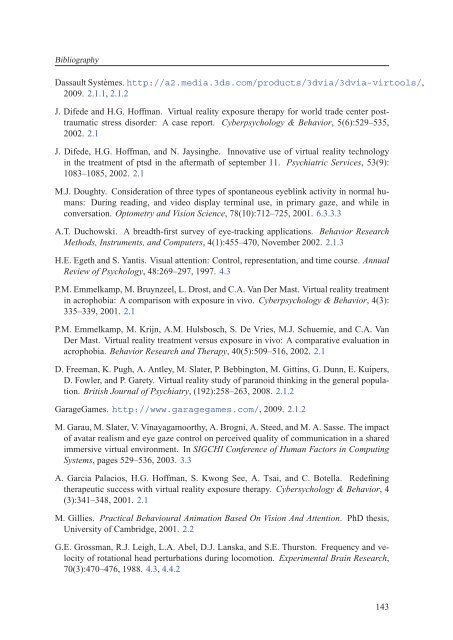Texte intégral / Full text (pdf, 20 MiB) - Infoscience - EPFL
Texte intégral / Full text (pdf, 20 MiB) - Infoscience - EPFL
Texte intégral / Full text (pdf, 20 MiB) - Infoscience - EPFL
Create successful ePaper yourself
Turn your PDF publications into a flip-book with our unique Google optimized e-Paper software.
Bibliography<br />
Dassault Systèmes. http://a2.media.3ds.com/products/3dvia/3dvia-virtools/,<br />
<strong>20</strong>09. 2.1.1, 2.1.2<br />
J. Difede and H.G. Hoffman. Virtual reality exposure therapy for world trade center posttraumatic<br />
stress disorder: A case report. Cyberpsychology & Behavior, 5(6):529–535,<br />
<strong>20</strong>02. 2.1<br />
J. Difede, H.G. Hoffman, and N. Jaysinghe. Innovative use of virtual reality technology<br />
in the treatment of ptsd in the aftermath of september 11. Psychiatric Services, 53(9):<br />
1083–1085, <strong>20</strong>02. 2.1<br />
M.J. Doughty. Consideration of three types of spontaneous eyeblink activity in normal humans:<br />
During reading, and video display terminal use, in primary gaze, and while in<br />
conversation. Optometry and Vision Science, 78(10):712–725, <strong>20</strong>01. 6.3.3.3<br />
A.T. Duchowski. A breadth-first survey of eye-tracking applications. Behavior Research<br />
Methods, Instruments, and Computers, 4(1):455–470, November <strong>20</strong>02. 2.1.3<br />
H.E. Egeth and S. Yantis. Visual attention: Control, representation, and time course. Annual<br />
Review of Psychology, 48:269–297, 1997. 4.3<br />
P.M. Emmelkamp, M. Bruynzeel, L. Drost, and C.A. Van Der Mast. Virtual reality treatment<br />
in acrophobia: A comparison with exposure in vivo. Cyberpsychology & Behavior, 4(3):<br />
335–339, <strong>20</strong>01. 2.1<br />
P.M. Emmelkamp, M. Krijn, A.M. Hulsbosch, S. De Vries, M.J. Schuemie, and C.A. Van<br />
Der Mast. Virtual reality treatment versus exposure in vivo: A comparative evaluation in<br />
acrophobia. Behavior Research and Therapy, 40(5):509–516, <strong>20</strong>02. 2.1<br />
D. Freeman, K. Pugh, A. Antley, M. Slater, P. Bebbington, M. Gittins, G. Dunn, E. Kuipers,<br />
D. Fowler, and P. Garety. Virtual reality study of paranoid thinking in the general population.<br />
British Journal of Psychiatry, (192):258–263, <strong>20</strong>08. 2.1.2<br />
GarageGames. http://www.garagegames.com/, <strong>20</strong>09. 2.1.2<br />
M. Garau, M. Slater, V. Vinayagamoorthy, A. Brogni, A. Steed, and M. A. Sasse. The impact<br />
of avatar realism and eye gaze control on perceived quality of communication in a shared<br />
immersive virtual environment. In SIGCHI Conference of Human Factors in Computing<br />
Systems, pages 529–536, <strong>20</strong>03. 3.3<br />
A. Garcia Palacios, H.G. Hoffman, S. Kwong See, A. Tsai, and C. Botella. Redefining<br />
therapeutic success with virtual reality exposure therapy. Cybersychology & Behavior, 4<br />
(3):341–348, <strong>20</strong>01. 2.1<br />
M. Gillies. Practical Behavioural Animation Based On Vision And Attention. PhD thesis,<br />
University of Cambridge, <strong>20</strong>01. 2.2<br />
G.E. Grossman, R.J. Leigh, L.A. Abel, D.J. Lanska, and S.E. Thurston. Frequency and velocity<br />
of rotational head perturbations during locomotion. Experimental Brain Research,<br />
70(3):470–476, 1988. 4.3, 4.4.2<br />
143

















